
Don’t worry, if you can’t find your color here, there’s plenty more swatches to look at in the back. Image Credit: Flickr User Clean Wal-Mart (CC BY 2.0)
“You need to go back to the paint store, Jim,” Anne says. “Look at it. It’s hideous.” “You can’t even see it,” says Jim. “The wall’s white. What do you want?” “I want it to be the same white,” says Anne. “I can see it. Right there.” She points to a roller’s width of paint on the living room wall. It almost blends in with the rest. “The Hunters are coming over for dinner tomorrow. You know that if our walls aren’t all the same shade of white that I’m gonna hear about it from Stephanie, and then from the rest of the neighborhood when I take the kids to swim practice next week. I swear she doesn’t have anything better to do.” Jim scowls. He crosses his arms across his chest. “Maybe I’ll paint that Stephanie white,” he says. “Maybe you’ll go back to the paint store,” says Anne. “Any why don’t you take a chip of paint with you so you get it right this time.”
Inaccurate Printed Color Swatches are Replaced with Spectrophotometers
Color matching has long been a standard offering of paint retailers. In the old days, it involved thousands of different printed color swatches homeowners or contractors could visually pair with the sample they wanted to match to. They’d bring in a paint chip from their wall, a cut-out from a magazine, or maybe something weird like a bird’s feather. Then they’d compare their sample to the printed swatches and pick the closest match. Your technician would then run out to the stock room or mix up a new can, and they’d be on their way.
This method resulted in a lot of complaints of poor color matches, which meant unhappy customers. Printed swatches aren’t the same color as liquid paint in a can or solid paint on a wall. The fluorescent lighting of your store isn’t the same as the incandescent or LED lighting of a home’s interior and certainly isn’t the same as daylight through a window or on an exterior surface. Matching under these conditions will yield results that are fairly close to the desired color, and if people aren’t picky, that’s probably close enough. However, some people want exact matches, and as the human eye can distinguish between millions of discrete colors1, they’ve got a lot to pick from. So paint retailers found a better way.
Spectrophotometers: your store almost certainly already has one2. When a customer brings in the color swatch that they want their walls to look like, your technician zaps it with the spectrophotometer, which quantizes the color measurement into exact color coordinates. These numbers are fed directly into your automated mixer and produce the exact shade that the customer desires. It’s simpler, quicker, and more accurate than the old system.


